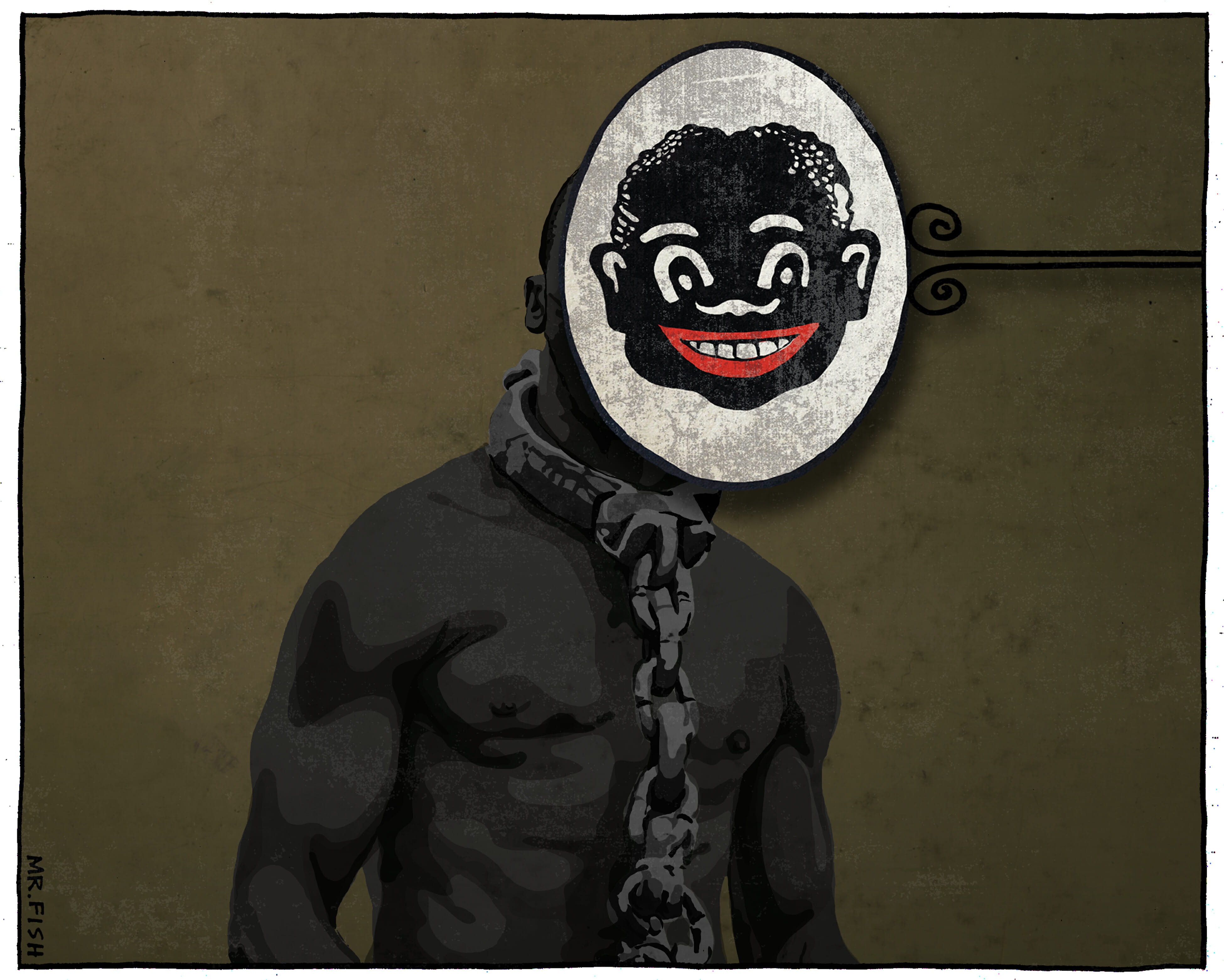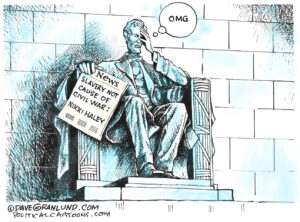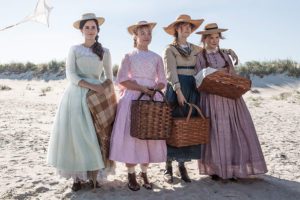Lynching the Past
Many Southern whites continue to lie to themselves and the world about the Civil War and the antebellum South. These lies perpetuate the evil they seek to hide. Mr. Fish / Truthdig
Mr. Fish / Truthdig
JONESBORO, Ga.—I boarded the Gone With the Wind Tour bus outside the train depot built in 1867 to replace the depot burned during the Civil War. The building now houses the Road to Tara Museum. It has displays of “Gone With the Wind” movie memorabilia including dolls of Mammy, played in the film by Hattie McDaniel, and the pantalettes and green hat worn by Vivien Leigh, who played Scarlett O’Hara.
Rick, the bus driver, switched on the audio track, written and narrated by a local historian, Peter Bonner. We listened to the familiar story of the noble South and its “Lost Cause.” We heard about the courage of the Confederate soldiers in Jonesboro who fought gallantly on Aug. 31 and Sept. 1, 1864, in a failed effort to block the Union Army from entering Atlanta. We were told of the gentility and charm of the Southern belles. We learned that the war was fought not to protect the institution of slavery but the sanctity of states’ rights. Finally, we were assured that the faithful slaves, the “mammies,” “aunties” and “uncles,” loved their white owners, were loved in return and did not welcome emancipation.
That this myth persists and perhaps has grown as the country polarizes, often along racial lines, means that whole segments of the American population can no longer communicate. Once myth replaces history there is no way to have a rational discussion rooted in verifiable fact. Myth allows people to deny who they are and the crimes they committed and continue to commit. It is only by confronting the past that we can end the perpetuation of these crimes in other forms.
When loyalty to the tribe is more important that truth, fact or justice—a tribalism on display in the hearings for Supreme Court nominee Brett Kavanaugh—an open society is extinguished. Reparations for African-Americans are not only just, they are the only way we as a nation, as with Germany’s reparations to the Jews, can build a shared history based on truth, atone for the crimes of the nation and reverse the legacies of white supremacy. The Southern cause, as Ulysses S. Grant wrote in his laconic memoirs, was “one of the worst for which a people ever fought, and one for which there was the least excuse.”
David Blight in “Race and Reunion: The Civil War in American Memory” documents that in the decades after the war whites in the South and the North furiously rewrote the history of the conflict. “As long as we have a politics of race in America, we will have a politics of Civil War memory,” Blight notes. The root cause of the war, the need to emancipate 4 million people held in slavery, was erased, he said, and replaced with the “denigration of black dignity and the attempted erasure of emancipation from the national narrative of what the war was about.” As W.E.B. Du Bois lamented in his book “Black Reconstruction,” which looked at the brief postwar period, from 1865 to 1877, when African-Americans were given some political space in the South to resurrect their lives, “little effort [was] made to preserve the records of Negro effort and speeches, action, work and wages, homes and families. Nearly all of this has gone down beneath a mass of ridicule and caricature, deliberate omission and misstatement.”
The Civil War, as portrayed in novels and films such as “Gone With the Wind,” histories such as “The Civil War” by Shelby Foote and television programs such as Ken Burns’ documentary series on the conflict, is usually reduced to stories about the heroic self-sacrifice and courage exhibited by the soldiers from the North and the South who fought as brother against brother. The gruesome suffering, widespread looting and rape and senseless slaughter are romanticized. (For every three soldiers who died on a battlefield, five more died of disease, and, overall, 620,000 Americans, 2 percent of the country’s population, perished in the war.) Meanwhile, the far more important struggle, the struggle of black people to rise from bondage to be free, is effectively eclipsed in these narratives of white self-pity and self-exaltation.
“Gone With the Wind,” the 1936 novel by Margaret Mitchell, has sold over 30 million copies worldwide and, according to one survey, is the second favorite book among Americans, after the Bible. The 1939 film version of the book is the highest-grossing movie ever, in inflation-adjusted dollars. The book and film are unapologetic celebrations of historical myth, historical erasure and white supremacy.
The Lost Cause romance and veneration of Confederate military leaders have a powerful hold on white imaginations, especially among those for whom economic and political marginalization is becoming more pronounced. The myth of the Confederacy resembles the retreat into a fictional past I saw in Yugoslavia during the Bosnian War, an ethnic conflict that lasted from 1992 to 1995. That retreat gave Yugoslavs—whether Serb, Muslim or Croat—who had been cast aside by economic collapse and a failed political system manufactured identities that were rooted in a mythologized past of glory, moral superiority and nobility. It allowed them to worship their own supposedly unique and innate virtues. These fantasies of an idealized past were accompanied by the demonization of opposing ethnicities, a demonization used by demagogues to fuel the hatred and violence that led to a savage war.
“He was a man that gave up his country to fight for his state, which 150 years ago was more important than country,” White House chief of staff and former Marine Corps Gen. John Kelly said last year of the Confederate military commander, Robert E. Lee, a slave owner. “It was always loyalty to state first back in those days. Now it’s different today.” Kelly blamed the Civil War on “the lack of an ability to compromise,” adding that “men and women of good faith on both sides made their stand where their conscience had them make their stand.”
During my bus ride in Georgia, a woman on the audio guide impersonated Scarlett O’Hara as music from the 1939 movie played in the background: “Now y’all sit back and enjoy this journey back into a time of cavaliers, ladies fair, and cotton fields—called the Old South.”
The theme of the tour could be summed up as “ ‘Gone With the Wind’ accurately portrays life in the South during and after the Civil War.” Over and over, incidents and characters in the novel and film were related to actual events and people. Nowhere was this more pernicious than in the portrayals of black men and women who were enslaved.
“I learned that a black servant 144 years ago so loved her ‘masters’ that she requested to be buried in their family plot. … And when I learned that her masters willingly allowed such a burial request, I had to conclude that there must have been a greater bond, perhaps a loving bond of slave for master, and master for slave,” Bonner writes in his thin book “Lost in Yesterday,” which is sold in the Road to Tara Museum. “The unique and often misunderstood relationship has been presented throughout fiction and the entertainment media, in my opinion, in a multitude of unfair portrayals.”
Bonner goes on to argue that the slaves in the book and the film—Mammy, Pork, Prissy and Big Sam—all supporters of the Confederacy and loyal to the O’Hara family, represent a true picture of many, maybe most, blacks in the antebellum South. He cites the small headstone at the feet of Philip and Eleanor Fitzgerald in the local cemetery that reads “Grace, Negro servant of the Fitzgeralds” and insists “that Grace was honored as a family member.”
That Grace was given no last name on the stone and was buried, like a pet, at the feet of those who owned her seems to escape Bonner. Did Grace have a family? A mother? A father? Brothers? Sisters? Grandparents? Aunts? Uncles? Cousins? A husband? Children of her own? Or had they been sold by her beloved owners?
We stopped outside the 1839 Stately Oaks plantation house, which originally sat on 404 acres before being moved into the city. It is now part of the Margaret Mitchell Memorial Park. The mansion hosts white re-enactors in period costumes, including Confederate uniforms, the equivalent of re-enactors dressed in SS uniforms giving cheery tours of Auschwitz.
In squalid, overcrowded shacks outside Stately Oaks, children were born, lived and died enslaved. They spent a lifetime engaged in hard labor, misery and poverty. They watched in agony as mothers, fathers, sisters and brothers were sold off, never to be seen again. They lived in constant fear and humiliation. They were beaten, chained, whipped, castrated and sometimes shot or hanged. The male slave masters routinely raped black girls and women, sometimes in front of their families, and often sold their mixed-race children.
“Like the patriarchs of old,” Mary Chesnut, a white South Carolinian, confided in her diary in March 1861, “our men live all in one house with their wives and concubines; and the mulattoes one sees in every family partly resemble the white children. Any lady is ready to tell you who is the father of all the mulatto children in everybody’s household but her own. Those, she seems to think, drop from the clouds.”
The Southern tradition, as James Baldwin pointed out, “is not a tradition at all.” It is “a legend which contains an accusation. And that accusation, stated far more simply than it should be, is that the North, in winning the war, left the South only one means of asserting its identity and that means was the Negro.”
The ability to disregard the horror of slavery, to physically erase its reality, and to build in its place a white fantasy of goodness, courage and virtue speaks to the deep sickness within American society. Most Confederate monuments were erected under the leadership of the Daughters of the Confederacy from 1890 to 1920, a time when the terror of lynching by the Ku Klux Klan was at its peak. These statues were designed to romanticize white supremacy and divide blacks into good and bad “negros.” There are no statues to Reconstruction governors and senators or black political leaders, not to mention the leaders of slave revolts such as Nat Turner or Denmark Vesey. The few Confederate generals, such as James Longstreet, who supported black rights after the war are not memorialized, nor are the 186,000 black soldiers—134,111 conscripted from slave states—who served in the Union Army. The historian James Loewen calls the South “a landscape of denial.”
“Public monuments,” the historian Eric Foner writes, “are built by those with sufficient power to determine which parts of history are worth commemorating and what vision of history ought to be conveyed.”
One of the most outrageous public celebrations of white supremacy is Stone Mountain outside of Atlanta. Carved in the gray stone are massive figures of Confederate President Jefferson Davis and the generals Robert E. Lee and Thomas “Stonewall” Jackson. The Confederate leaders, all mounted on horses, hold their hats over their hearts. The carving covers more than 1.5 acres of rock face and rises 400 feet. It is the largest bas-relief in the world. It is also the most visited site in Georgia.
William Faulkner published “Absalom, Absalom,” his searing condemnation of slavery and the Old South the same year Mitchell published “Gone With the Wind.” The hate-filled slave owner and Confederate veteran Thomas Sutpen in Faulkner’s novel, unlike the characters in “Gone With the Wind,” is “demonic evil.” Sutpen, who engages in miscegenation, buys his slaves “with the same care and shrewdness with which he chose the other livestock—the horses and mules and cattle.” Faulkner understood “the past is never dead. It’s not even past,” that it is subject to constant revision by those seeking to justify and hide their crimes. He warned that the lies we tell ourselves about ourselves lead to moral squalor and self-destruction.
The tour bus stopped at Patrick Cleburne Memorial Cemetery, which holds the remains of some 1,000 Confederate soldiers who died in the Battle of Jonesboro. Most are unidentified. The walkway is laid out in the shape of a Confederate flag. A Confederate flag flies at the entrance.
“In 1872, the state of Georgia pays Stephen Cars, a local cabinetmaker, to rebury the Southern soldiers’ remains and place them in the Patrick Cleburne Memorial Cemetery here,” the audio recording said. “Mr. Cars did not bury over a thousand soldiers by himself. Mr. Cars had a slave named Tom who left with a Yankee captain after the Battle of Jonesboro. When the war was over, Tom returned to Mr. Cars’ house asking for his job back. It was in 1872 that Tom and Mr. Stephen Cars reburied the Confederate soldiers in this cemetery. I told this story to the state of Georgia building authority years ago, they oversee the cemetery, and they remarked that Tom was very similar to the O’Hara slave Big Sam.”
The bus paused in front of a 10-room green house built in 1880 that once belonged to the president of Middle Georgia College.
“Under Reconstruction, five Southerners were not allowed to meet together without a federal marshal present,” Bonner said on the audio guide. “In ‘Gone With the Wind,’ meetings were held in secret. In Jonesboro, there were those secret meetings that dealt with the issues the town had to deal with, including the violence in shantytown. Shantytown was a real location in Jonesboro and many other cities that had a large population of former slaves who are without a job or a home. When this house was being restored in 1995, it was found to have a secret room in the attic, believed to have been used for those secret meetings. There was also a ladder in the wall leading to the cellar. In the cellar, people believed they had found a tunnel. However, upon further research, they found out it was not a tunnel but a bomb shelter where the city fathers planned to store the county records if and when they got back to war” (meaning if and when they resumed the fight against the Union).
It is a safe bet that this house was also a meeting place for the heavily armed goons of the Ku Klux Klan, who rode four abreast at night through the Jonesboro streets to terrorize the blacks in “shantytown.” Over 4,000 people were lynched between the end of the Civil War and World War II in the United States. Georgia had the second highest number of lynchings, with 589. Only Mississippi, with 654 murders, had more.
Lynching was a popular public spectacle in Georgia that could last for hours and included sadistic torture and mutilation. Children were let out of school and workers were given the day off to witness the events. When Sam Hose, who had thrown his ax at a white man and killed him after the man pulled a gun on him, was lynched on April 23, 1899, near Newman, Ga., 1,000 people attended. Many arrived on a special excursion train from Atlanta. Hose was stripped and chained to a tree. His executioners stacked kerosene-soaked logs around him. They cut off Hose’s ears, fingers and genitals. They flayed his face. Members of the crowd thrust knives into him. The logs were lit.
“The only sounds that came from the victim’s lips, even as his blood sizzled in the fire, were ‘Oh, my God! Oh, Jesus,’ ” writes Leon Litwack in “Trouble in Mind: Black Southerners in the Age of Jim Crow.” “Before Hose’s body had even cooled, his heart and liver were removed and cut into several pieces and his bones were crushed into small particles. The crowd fought over these souvenirs, and the ‘more fortunate possessors’ made some handsome profits on the sales. (Small pieces of bone went for 25 cents, a piece of liver ‘crisply cooked’ sold for 10 cents.) Shortly after the lynching, one of the participants reportedly left for the state capital, hoping to deliver to the governor of Georgia a slice of Sam Hose’s heart.”
On the trunk of a tree near the lynching, a placard read: “We Must Protect Our Southern Women.”
In May of 1918, Mary Turner, eight months pregnant, publicly denounced the lynching of her husband, Hazel “Hayes” Turner, who had been murdered the day before. She threatened to take those who lynched him to court. A mob of several hundred in Valdosta, Ga., hunted her down. They tied the pregnant woman’s ankles together and hung her upside down from a tree. They doused her clothes with gasoline and set her on fire. Someone used a hog-butchering knife to rip open her womb. Her baby fell the ground and cried briefly. A member of the mob crushed the infant’s head under the heel of his boot. Hundreds of rounds were shot into her body. The Associated Press reported that Mary Turner had made “unwise remarks” about the lynching of her husband “and the people, in their indignation, took exceptions to her remarks, as well as her attitude.”
In commenting in 1894 on lynchings, the crusading editor and activist Ida B. Wells said, “[O]ur American Christians are too busy saving the souls of white Christians from burning in hell-fire to save the lives of black ones from present burning in fires kindled by white Christians.”
James Baldwin, in the second half of the 20th century, repeatedly warned white Americans that their relentless refusal to honestly confront their past, and themselves, would lead to grotesque distortions of the sort that decades later we see embodied in Donald Trump. There is a severe cost, he wrote, for a life lived as a lie.
“People pay for what they do, and, still more, for what they have allowed themselves to become,” Baldwin wrote. “And they pay for it very simply by the lives they lead. The crucial thing, here, is that the sum of these individual abdications menaces life all over the world. For, in the generality, as social and moral and political and sexual entities, white Americans are probably the sickest and certainly the most dangerous people, of any color, to be found in the world today.”
The first recorded lynching in Georgia took place near Jonesboro in 1880. We have only the name of the victim, Milly Thompson. No one knows if Thompson was male or female. There is no record of Thompson committing a crime. But I suspect that, as in the cases of most lynching victims, the crime Thompson committed was the crime of freedom. If you were black, in this land of gallant cavaliers and Southern belles, and you objected to being human chattel and to enforced deference and submission to whites, they killed you.
Your support is crucial...As we navigate an uncertain 2025, with a new administration questioning press freedoms, the risks are clear: our ability to report freely is under threat.
Your tax-deductible donation enables us to dig deeper, delivering fearless investigative reporting and analysis that exposes the reality beneath the headlines — without compromise.
Now is the time to take action. Stand with our courageous journalists. Donate today to protect a free press, uphold democracy and uncover the stories that need to be told.






You need to be a supporter to comment.
There are currently no responses to this article.
Be the first to respond.